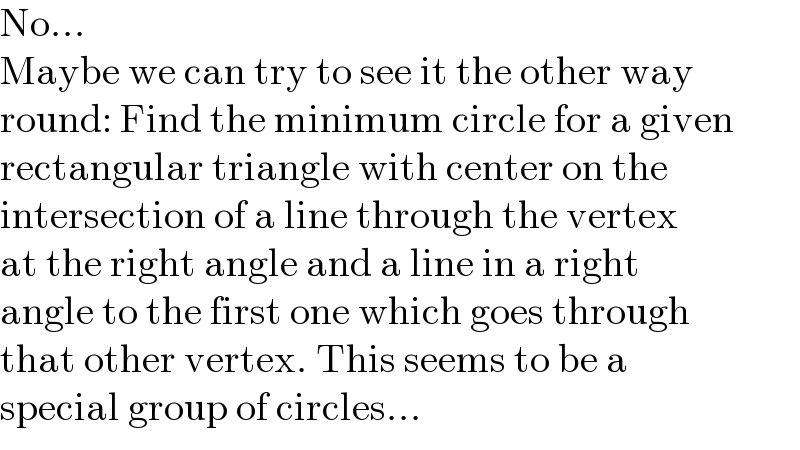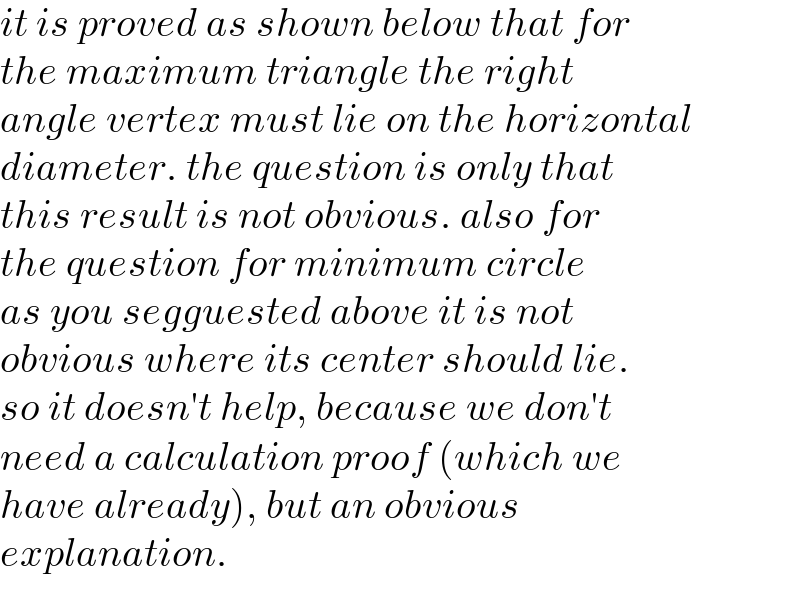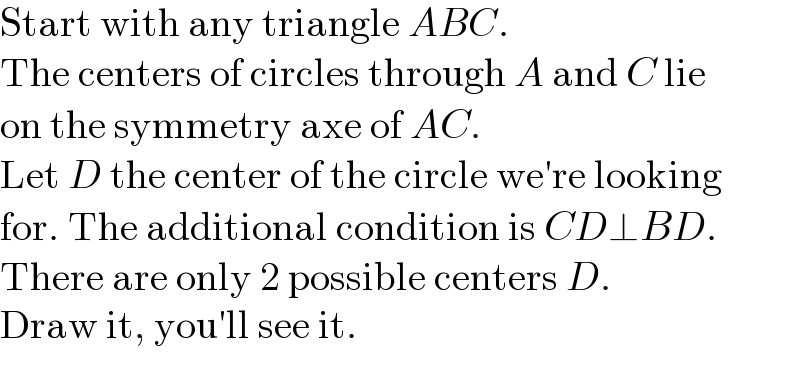
Question and Answers Forum
Question Number 186464 by mr W last updated on 04/Feb/23

Commented by mr W last updated on 04/Feb/23

Commented by Frix last updated on 05/Feb/23

Commented by Frix last updated on 05/Feb/23

Commented by mr W last updated on 05/Feb/23

Commented by mr W last updated on 05/Feb/23

Commented by Frix last updated on 05/Feb/23

Commented by mr W last updated on 05/Feb/23

Commented by mr W last updated on 05/Feb/23

Commented by mr W last updated on 05/Feb/23
![it′s easy to see Δ=[BCA]=[BCA′]=((hd)/2) d_(max) =diameter=2r ⇒Δ_(max) =((h×2r)/2)=hr when vertex C lies on the horizontal diameter.](Q186516.png)
Commented by ajfour last updated on 05/Feb/23
![Δ=[BCA]=[BCA′] understood but =((hd)/2) (how?)](Q186519.png)
Commented by mr W last updated on 05/Feb/23

Commented by mr W last updated on 05/Feb/23
![[BCA′]=[BCO]+[BOA′] =((BO×d_1 )/2)+((BO×d_1 )/2) =((BO×2d_1 )/2) =((h×d)/2)](Q186522.png)
Commented by ajfour last updated on 05/Feb/23

Commented by mr W last updated on 06/Feb/23

Commented by mr W last updated on 05/Feb/23

Answered by mr W last updated on 04/Feb/23

Commented by mr W last updated on 05/Feb/23
![a_1 a=c_1 c=(h−r)(h+r)=h^2 −r^2 a_1 =((h^2 −r^2 )/a) b^2 =c^2 −a^2 b^2 =(2r)^2 −(a−a_1 )^2 c^2 −a^2 =4r^2 −(a−a_1 )^2 c^2 =4r^2 +(2a−a_1 )a_1 c^2 =4r^2 +(2a−((h^2 −r^2 )/a))×((h^2 −r^2 )/a) ⇒c^2 =2(h^2 +r^2 )−(((h^2 −r^2 )^2 )/a^2 ) ⇒b^2 =c^2 −a^2 =2(h^2 +r^2 )−(((h^2 −r^2 )^2 )/a^2 )−a^2 area Δ=((ab)/2) let Φ=4Δ^2 =a^2 b^2 Φ=a^2 [2(h^2 +r^2 )−(((h^2 −r^2 )^2 )/a^2 )−a^2 ] Φ=2(h^2 +r^2 )a^2 −a^4 −(h^2 −r^2 )^2 Φ=2(h^2 +r^2 )a^2 −a^4 −(h^2 +r^2 )^2 +4h^2 r^2 ⇒Φ=4h^2 r^2 −(a^2 −h^2 −r^2 )^2 we see the maximum of Φ is 4h^2 r^2 when a^2 =h^2 +r^2 . that means the maximum area is Δ_(max) =hr, when the right angle vertex lies on the horizontal diameter.](Q186472.png)
Commented by mr W last updated on 05/Feb/23

